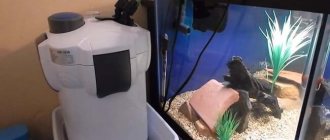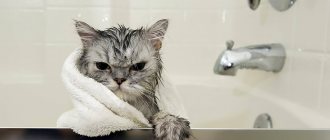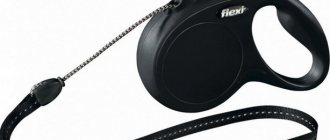There are many reptile lamps sold in pet stores today, but not all of them may be equally beneficial for your pets.
Moreover, the same lamp will demonstrate different efficiency under different conditions. When purchasing individual types, you will simply throw money away without getting the desired result.
So how do you choose the most useful lamp for your turtle and are they really necessary? Let's figure it out.
Features of keeping turtles
Under natural conditions, these creatures bask in the sun, receiving everything they need from their rays.
A sunbeam is a very rich spectrum in its components.
At home, you will have to recreate a similar microclimate for the full development and growth of the reptile. Therefore, at home they are placed in special aquariums or terrariums.
If your pet is a waterfowl, then you will have to make sure that the aquarium contains both water and land at the same time, in the form of a separate island. Moreover, the temperature on the island should not exceed certain degrees. Which ones will be discussed below.
At the same time, keep in mind that to grow a red-eared turtle, it should be a large aquarium, and not a small basin with palm trees and other crap. For normal growth they need a large space with all the conditions.
In general, keeping such pets entails significant costs for:
- aquarium with tray + reinforced cabinet for it
- powerful filter
- lighting and heating
- thermometers
- land or island
- decor
- cleaning accessories
So before buying a miniature and cute turtle in a pet store, be prepared for some significant expenses. And proper lighting is one of them.
How to use a UV lamp
An ultraviolet lamp guarantees a positive effect, but only if it is used correctly.
The amount of time for ultraviolet irradiation is different for each category of consumer:
- for animals (for reptiles in particular) - if it is possible to control the animal’s presence under the direct influence of such lighting, it is recommended for young individuals to use ultraviolet radiation for more than 4 hours a day, but for adults the use time should not exceed 3 hours. If this is not possible, then it is recommended to use the device throughout the daylight hours (10-12 hours). The lamp turns on only during daylight hours; you can turn off the lighting after the expiration date. The optimal time of use is from 8:00 to 20:00;
- for plants , the optimal time to use ultraviolet light is during daylight hours, but not more than 14 hours. At the same time, it is worth taking into account the peculiarities of the perception of such light by different plants, and therefore, if the decorative appearance is lost, the radiation dose must be reduced. The lamp turns on during daylight hours, the optimal time of use is from 8:00 to 22:00;
- for an aquarium - the recommendations of aquarists are limited to using the device for 1 hour daily. For neglected aquariums, eight hours of use is acceptable until the water quality improves. The lamp turns on throughout the night from 10:00 p.m. to 6:00 a.m.
To achieve a positive result when exposed to ultraviolet light, it is important to consider the basic safety rules:
- to avoid burns to the cornea of the eyes, only closed type devices can be used, i.e. the device must be in a housing;
- during the period of treatment and use of medicines by animals, the use of UV devices is unacceptable;
- fertilization for the growth of vegetation in the aquarium does not allow the use of UV filters.
Important! To avoid fires when using ultraviolet lighting for a long time, safety rules with electrical appliances recommend using surge protectors and voltage stabilizers for switching on.
UV lighting products are essential to use for animals, fish and plants. Ultraviolet radiation in limited doses is of great benefit to all living things and promotes the development and absorption of minerals, while also having an antiseptic effect. Devices of this kind have a wide range of products on sale, but for people who understand electrical devices, making such a UV lamp at home will not be difficult.
UVB and UVA rays - what are they?
What should it be like? First, remember, you will need to purchase not one, but two types of lamps.
One of them will be an ultraviolet lamp with a UVB and UVA wave spectrum.
When choosing such light bulbs, the percentage of UVB content is important.
For relatively mature turtles (over 7 years old), it should be at least 5% (UVB 100 or 5.0). For small water and all land animals, choose 10% UVB (or UVB 150 - 10.0).
In this case, initially the paw can be raised slightly higher than the recommended value, and after a couple of months, it is gradually lowered, thereby manually adjusting the level of ultraviolet radiation.
For sick or pregnant turtles, UV lamps containing 10-12% UVB (UVB 200) are recommended.
It is the UVB indicator that plays the greatest role. However, UVA rays in such bulbs are usually about 30%.
What exactly are UV A and UV B rays and what role do they play? Type A sun rays are the ones that cause our skin to tan.
However, they do not pass through the layers of the skin and are harmless in moderate quantities. But type B rays penetrate the skin and, if too intense, can cause diseases, including cancer.
Such lamps (UVB) have a wave spectrum in the range of 290-320 nm. Anything below this range is harmful to both humans and animals.
And anything above 320 nm does not in any way help the formation of vitamin D3.
Roughly speaking:
- UVA - warmth
- UVB – vitamins
- UVC - harm
Any reptile that requires calcium gets it from vitamin D3 (cholecalceferol).
And it, in turn, is synthesized precisely when the animal spends a limited time either under natural sunlight (containing rays A and B in its spectrum), or under special lamps, which are original substitutes for such rays.
Features of choosing ultraviolet lamps
It is important to know how to choose the right UV lamps for your terrarium. This will ensure the full development of the reptile and provide comfortable conditions for its living.
When choosing these devices, you should definitely take into account two important indicators:
- UVB. This indicator indicates the percentage of medium ultraviolet waves that the lamp can emit. Medium waves play an important role in the life of turtles; in the wild, they ensure the normal process of potassium absorption in the body of amphibians;
- UVA. This indicator indicates the percentage of long ultraviolet waves that the device produces. They provide great value to turtles.
But knowing the indicators of the lamps is not enough; in order for the turtle to fully develop and grow at home, certain standards of these indicators must be observed. They will primarily depend on the volume of the box containing one animal. On average it is 5-6 liters. In these terrariums the following standards must be observed:
- For this volume it is recommended to maintain UVB to 5-10%. If this figure is 2%, then it will not be enough. If pregnant individuals are kept in the terrarium, it is recommended to increase it to 12%;
- The UVA norm should be at least 30%. If its performance is low, this may negatively affect the condition of the reptile.
It is important to install the light device exactly with the recommended readings. If all conditions are met, then the pet will be completely safe, and it will also be protected from such an unpleasant disease as rickets. This disease is dangerous because during it softening and deformation of bone tissue occurs.
Is there an alternative to UV lamps?
Remember that no synthetic vitamin D or special food can fully replace this lighting. This primarily applies to land turtles.
Predators (red-eared animals), in natural habitats, receive an analogue of D3 through eaten animals.
Therefore, feeding sometimes saves them.
However, keeping aquatic turtles without UV for a long time is also not recommended. It's like putting you in a closet with one dim light bulb and stuffing you with all kinds of vitamins.
You will live, but you will acquire a bunch of diseases. The same applies to turtles.
Therefore, to the question “is it possible to do without ultraviolet radiation at all,” the answer is simple - no, it’s impossible.
On land turtles you will see the effects within a few weeks. For aquatic reptiles this will take a much longer period, but there will still be negative consequences.
Gradually, the turtle will develop rickets. The shell will become soft and brittle.
This also risks breaking limbs.
Placing an aquarium directly next to a window does not help, and cannot replace UV lamps. The fact is that sunlight passing through glass almost completely loses ultraviolet radiation, and you will not get any effect or benefit from such savings.
The dangers of ultraviolet light bulbs
Is such ultraviolet radiation dangerous for humans and other animals? In the quantities emitted by UVB lamps, no, it is not dangerous. You won't even tan under these rays.
What to do if such a light bulb breaks?
Well, firstly, there is very little mercury vapor in them. So no one will get fatal poisoning.
Secondly, you will need to carry out basic disinfection measures. Wear gloves to remove fragments and white powder (luminophor). Next, ventilate the room for 1 hour.
It is not recommended to throw used lamps in the trash.
Hand them over to special points.
Service life - why so short?
The service life of all such UV lamps is limited and ranges from 3 months to 1 year (depending on the brand and manufacturer).
Please pay special attention that after this period, the lamp must be replaced, even if it has not burned out!
During this time, the ultraviolet spectrum of the light fades away and the light bulb turns into a useless backlight, losing all its UVB percentages.
This occurs due to the burnout of the fluorescent composition and the transition of the spectrum to a longer wavelength. Applies to both tubes and compacts.
And as mentioned above, anything above 320 nm no longer has any benefit and does not contribute to the production of vitamin D3.
That is, light bulbs do not become harmful, they become useless. They can be placed in an aquarium with fish or plants.
Also, the service life depends on power surges (tubes are more durable in this regard), the humidity level in the aquarium, heating temperature and other factors. Therefore, be aware that if it says 1 year on the package, this does not mean that the light bulb will work for exactly the time stated by the manufacturer.
Tips for caring for a red-eared slider
The first thing you should pay attention to is how well and efficiently the light bulb provides warmth to the reptile. In this case, the most profitable solution would be to purchase an ordinary small incandescent lamp, since it can provide high temperatures in the terrarium. Its type depends on personal preferences and boxing qualities. Most often, this source is located above the place where the land will be located.
The second factor, which is also considered important, is a sufficient amount of ultraviolet radiation for the red-eared slider. Turtles need UV for proper development and existence. The rays help the reptile produce vitamin D3, which helps the body maintain certain processes.
A regular lamp cannot provide the required amount of UV, so special UV lamps for turtles are adapted to give the reptile the daily requirement of the vitamin. It is worth making sure that the red-eared turtle receives ultraviolet light, especially in the winter season, since this is the moment when the sun is far away and cannot additionally nourish the animal with vitamins.
Lighting is an essential component of a terrarium. To ensure the normal viability of the reptile, eight to twelve hours of daylight is enough, after which all lamps for the red-eared turtle can be turned off.
Lamp with or without reflector?
When choosing lamps, it also matters which lamp you screw it into. The fact is that such UV lamps do not have any reflector and they scatter light in all directions.
Therefore, the most effective are lamps equipped with reflectors.
They have a shielded surface in the dome that concentrates the rays and directs them in a given direction. Here is a clear example of two different lamps with the same bulbs and the measured UVB level from them.
The efficiency of a model without a reflector is two times less!
Therefore, think carefully before installing UV bulbs in the body of a regular table lamp.
Do you want to lose such a share of useful radiation?
Place and height of installation of UV lamps in the aquarium
Where to place UV lamps in an aquarium? Compact ones should be located above the island, at a height of about 20-25cm from its level (with a power of about 25W).
Power 15W – 15-17cm from the surface.
In this case, there should be no protective glass between the turtle and the light bulb.
Otherwise, it will retain all the useful ultraviolet radiation.
Fluorescent tubes are attached to the lid and shine evenly over the entire aquarium, and not just on the island.
After installing the lamp at the calculated height, be sure to observe the behavior of the turtle for the first time. If she starts to show anxiety (she starts rubbing her eyes frequently, although this hasn’t happened before), then raise the light bulb a little higher!
Terms of use
If you do not install the correct light right away, then within two weeks the land turtles will begin to have health problems. You need to turn on the lamp all day (10-12 hours), and turn it off at night. It is recommended to place it at a distance of 20−40 cm from the ground or 20 cm from the shore of the aquarium. The more accurate distance depends on the lamp power and UVB percentage. It is believed that the optimal ultraviolet frequency is from 290 to 310 nm, peak - 294. Light below 290 nm becomes harmful, and that above 310 nm does not produce, but destroys D3.
In order for the necessary light to reach your pet, the lighting device must be hung above the ventilation mesh or even above the turtle itself so that the glass of the aquarium is not between the reptile and the ultraviolet rays. This is due to the fact that window glass and polycarbonate completely block ultraviolet radiation, and plexiglass partially.
There should be no glass between the lamp and the turtle
To increase the power, you can use reflectors that can make the radiation 2 times stronger. They look like curved aluminum plates. Without reflectors, the power cannot be increased, but if necessary, you can lower the lampshade, but not lower than 15 cm from the turtle.
Instrument replacement frequency
The lighting fixture must be replaced before it burns out. This is due to the fact that over time the filling, which shifts the emission spectrum into ultraviolet, burns out. It goes into the red area. Such lighting will not harm the animal, but will be absolutely useless.
The service life of the device is indicated on the packaging, but you cannot always trust what is written. The easiest way to understand that it's time to change the lamp is to turn on a new one next to it. Usually the difference in light between an old and a recently purchased device can be seen with the naked eye.
The lamp must be changed before it burns out.
Unsuitable types of lamps
There are lighting fixtures that produce a similar light, but they have a different effect and are completely useless for reptiles. These include lamps:
- medical;
- for plants and fish;
- with a UVB spectrum of less than 5% or without UVB indication;
- quartz;
- luminescent;
- blue, including those used for treatment;
- for drying nails;
- UV for money.
Recommended Settings
Lamps with a spectrum containing 30% UVA and 5−12% UVB are suitable for turtles. Experts recommend using them as follows:
- 5−8% UVB is suitable for waterfowl;
- for land - 8−12% UVB;
- for sick (including rickets) and weak animals it is better to set 10-12% UVB.
If these parameters are not indicated on the packaging, then it is better to refuse the purchase or check the parameters with the manufacturer. When ordering a device from the USA, you need to be careful because it may be rated for 110 volts rather than 220 volts.
You can replace the UV lamp for turtles with erythema lamps, which are used for tanning. Their ultraviolet radiation is harsher than in special devices, so they should only shine for 5-10 minutes a day. The light from such devices should not be allowed to shine into the pet’s eyes, as this can seriously damage the eyesight.
It will not be possible to make an ultraviolet lamp for turtles with your own hands, since for this you need to meet a lot of requirements. Since the health and life of a reptile depends on the correct parameters, it is better not to risk trying to replace the UV lamp with homemade devices.
Heating lamp in a terrarium
The second necessary lamp is a regular or mirror incandescent light bulb with a power of 40 to 60 W.
Since the turtle is a cold-blooded animal, all processes in its body depend on the ambient temperature. The incandescent light bulb creates the necessary warmth, like the summer sun.
It needs to be installed again above the island, and at such a height that the temperature below is 31-32 degrees.
Measure everything with a thermometer, adjusting the height of the suspension from 20 to 30 cm.
The height will depend primarily on the power of the light bulb. The optimal value is selected experimentally for each aquarium.
From the experience of other turtle lovers, we can give approximate calculations:
- 40W – suitable for small terrariums
Creates a temperature of about 29 degrees at the heating point.
- 50W – for aquariums with dimensions 50*35*30
Provides optimal temperature on the island of 30-33 degrees.
- 60W – for large aquariums 60*40*40
Warms up to a maximum of 35-40C.
The location of the suspension and the height can be adjusted with special sockets with wires on detachable plugs.
JBL has these in stock.
Glow time
How long should both reptile lamps be on? Both regular and UV should burn throughout the daylight hours from 10 to 12 hours. At night they are turned off.
To automate this process, it is advisable to purchase a timer socket or time relay.
You manually set the lighting start time (8.00 am) and shutdown time (20.00 pm) on them. Automation will do the rest for you.
In the morning you will be able to sleep longer, and in the evening you will not be distracted from watching your favorite TV series.
Secrets
Please pay attention to how to choose a UV lamp for turtles.
- The quality of the ultraviolet lamp for reptiles is of great importance. The best solution may be a regular small incandescent type. It will provide the required temperature conditions inside the terrarium. Depending on your individual indicators, select the type you need. The most common location for its installation is the area above the bridge. This area is where the land is.
- The amount of UV rays. For the normal development of the turtle, it is important to select UVB, with the help of which vitamin D3 is produced in normal quantities. Ordinary lamps are not capable of becoming an alternative to UV rays.
- Take care of the quality of lighting. Pay attention to this indicator in winter. After all, during this period the animal does not receive a supply of vitamin from the sun.
Similar: DIY TV matrix repair
The terrarium should be well lit. For the normal functioning of an animal, 8-12 hours a day of UV illumination is sufficient. The rest of the time you can turn it off.
Dangerous lamps for turtles
Now let's touch on the issue of lamps, which under no circumstances should be installed in an aquarium for turtles.
The following species are a dangerous source of light for them and contribute to the development of all kinds of diseases.
- UV lamps for drying gel polishes or lamps for manicure
- infrared medical heating lamp
- black UV lamp
- UV models for checking banknotes
- lamps from medical UV lamps
- lamps for plants
From these lamps, your turtle will receive radiation, which will lead to burns of the corneas of the eyes and blindness.
Therefore, be careful and install only lamps specifically designed for reptiles.
Terms of use
If in winter the room where the pet lives is cool, then in addition to light, the light bulb should also provide heat. But you should not install it closer than 30 centimeters to the animal. Close proximity will lead to burns of soft tissues and the ocular surface.
In order for an aquatic turtle to live and feel fully, the terrarium must contain two zones: water (cool), land (warm).
The maximum temperature of the warm zone is up to 40 degrees.
The water level is also taken into account. When turning the animal onto its back, there should be enough space to return to its original position.
There are three types of lamps sold in stores:
- tubular;
- compact;
- metal-steam.
The installation of these types is different. Tubular ones require the installation of the required lampshade or grooves. Compact ones are screwed into a standard E27 base. To operate a metal vapor lamp, you need a special starter. The first option is suitable for lighting large terrariums, while compact ones are suitable for small aquariums.
When installing, the location of the lamp is also taken into account so that the animal cannot loosen it. The wiring must be in good working order to prevent electric shock.
Thus, for correct placement the following nuances are taken into account:
- type of ultraviolet light bulb;
- distance between the lamp and the animal;
- type of pet;
- temperature regime;
- lighting area.
Lighting should be uniform throughout the entire boxing area. No dark areas allowed.
Do not install lamps on the side. This will irritate the animal.
If the lamp is intended for heating reptiles, then it should work only during the daytime and should be turned off at night. An infrared lamp is often used to maintain temperature.
Also, the operating time of the ultraviolet source depends on the age of the turtle:
- up to two years of age, the animal requires more lighting and warmth;
- after two years, the perception of UV rays is lost, so the source is used for a short period of time - up to three hours.
If it is not possible to constantly monitor the lighting, then you need to install an ultraviolet light bulb with automatic shutdown. It is equipped with a timer that is programmed for the desired period of inclusion.
Some owners install Photon lamps in terrariums. But they are used to apply tanning and for the animal the switching on is carried out for no more than five minutes.
UV+heat combination bulbs
In addition to the UV and incandescent lamps discussed, there are also combination lamps that simultaneously heat and produce ultraviolet light. The so-called UV + heating.
They cost significantly more. However, among them, most of the models, which, while emitting good heat, do not emit so much ultraviolet radiation. With separate lighting you can get much more of it.
At the same time, if a light bulb in separate lighting fails, you will need to replace one thing - an ultraviolet light or an incandescent lamp. In the combined version, you risk being left without light altogether.
The best option is to use UV lamps T8, T5 in the lid of the aquarium and ordinary lamps above the island. The tubes will provide uniform ultraviolet illumination over the entire area, and the regular tubes will comfortably warm up the turtle’s shell.











